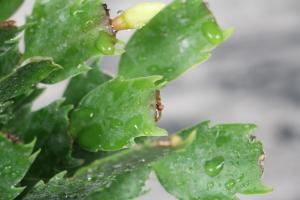Introduction
Ladybugs, also known as ladybirds or lady beetles, are a common sight in gardens and parks during the summer months. These small insects are known for their distinctive red or orange coloration with black spots, and are often seen crawling on leaves and branches. However, many people wonder if ladybugs are actually beneficial for indoor plants. In this article, we will explore the reasons why ladybugs are good for indoor plants and how they can help to keep your plants healthy and thriving.
Benefits of Ladybugs for Indoor Plants
There are several reasons why ladybugs are beneficial for indoor plants. First of all, ladybugs are natural predators of many common insect pests, such as aphids, mites, and mealybugs. By feeding on these pests, ladybugs can help to control infestations and prevent damage to your plants.
In addition, ladybugs are also beneficial for pollination. Although they are not as effective as bees and other pollinators, ladybugs can still help to transfer pollen from flower to flower, which can improve the yield of your plants.
Finally, ladybugs can also act as a natural fertilizer. As they feed on pests and other insects, ladybugs produce waste that contains valuable nutrients for your plants. This can help to improve the overall health and growth of your indoor plants.
How to Attract Ladybugs to Your Indoor Plants
If you want to encourage ladybugs to visit your indoor plants, there are several things you can do. First of all, you should avoid using pesticides and other chemical treatments that can harm ladybugs and other beneficial insects.
Instead, try to create a welcoming environment for ladybugs by providing them with a source of water and shelter. You can also plant flowers and herbs that are attractive to ladybugs, such as daisies, marigolds, and fennel. These plants can help to attract ladybugs to your indoor garden and provide them with a source of food and protection.
Finally, you can also purchase ladybugs from a garden center or online retailer. These ladybugs are typically sold in containers and can be released into your indoor garden. However, it is important to note that not all types of ladybugs are suitable for indoor use, so be sure to do your research before making a purchase.
Tips for Caring for Ladybugs in Your Indoor Garden
If you do decide to introduce ladybugs to your indoor garden, there are a few things you should keep in mind to ensure their health and well-being. First of all, make sure that your plants are free from any harmful chemicals or pesticides that could harm ladybugs.
You should also provide a source of food and water for the ladybugs, such as a shallow dish filled with water and sugar. This can help to keep them hydrated and provide them with the nutrients they need to thrive.
Finally, it is important to monitor the population of ladybugs in your indoor garden. While ladybugs are beneficial for your plants, too many ladybugs can be overwhelming and may harm your plants. If you notice an excessive number of ladybugs, you may need to remove some of them to maintain a healthy balance in your indoor garden.
Conclusion
In summary, ladybugs are beneficial for indoor plants thanks to their role as natural predators, pollinators, and fertilizers. By attracting ladybugs to your indoor garden, you can help to control insect pests and improve the overall health and growth of your plants. However, it is important to keep in mind that not all ladybugs are suitable for indoor use, and you should follow proper care and maintenance to ensure their health and well-being in your indoor garden.

 how many times do yo...
how many times do yo... how many planted tre...
how many planted tre... how many pine trees ...
how many pine trees ... how many pecan trees...
how many pecan trees... how many plants comp...
how many plants comp... how many plants can ...
how many plants can ... how many plants and ...
how many plants and ... how many pepper plan...
how many pepper plan...































